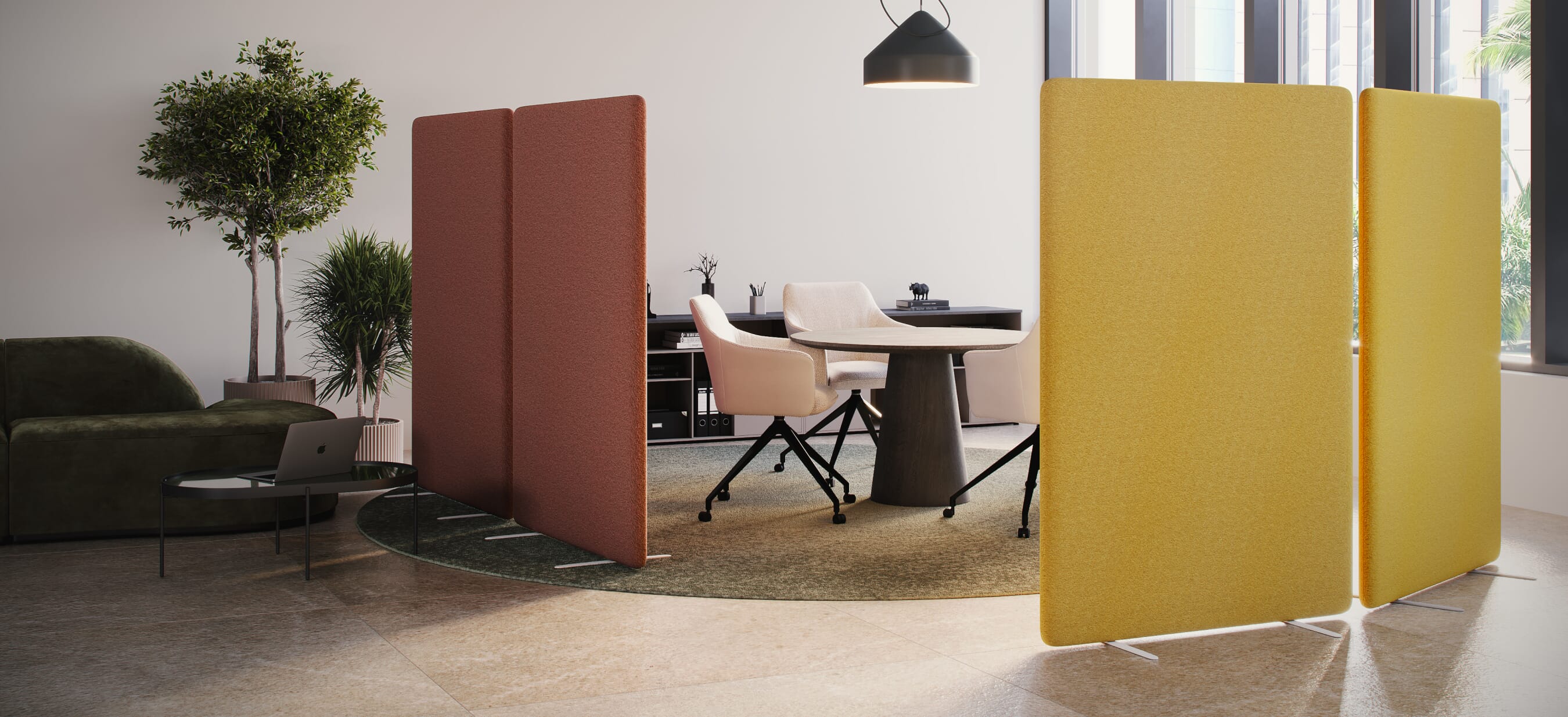What is Acoustics? An Introduction to Workplace Acoustics
What is acoustics?
In design, 'acoustics' refers to how sound is transmitted within a room or building. It's affected by the properties of the room, such as the size and shape, as well as the furnishings and materials used in decorating the space.
To understand acoustics, we first have to understand how sound works. Sound is a form of energy which travels through the air in waves, which is then interpreted by our brains.
Volume
The volume of a sound (also known as loudness or intensity) is measured in decibels (dB), which uses a logarithmic scale. This means that each number on the scale is relative to the one before, e.g. 20dB is ten times louder than 10dB, and 30dB is one thousand times louder.
Noises above 85dB are considered extremely loud, and continued exposure to sounds such as sirens, airplanes, and heavy machinery may harm hearing.
Frequency
The tone of a sound depends on the frequency; the higher the frequency, the higher the tone. Lower sounds like a bass have a frequency of around 20-60 Hz, whereas the highest note on a piano is 4186Hz.
Human ears can perceive between 20-20,000Hz, and particularly high or low frequencies can be extremely uncomfortable and even cause pain, headaches, nausea, and fatigue.
Improving the acoustics of a room can mitigate the negative effects of harsh frequencies and loud noises such as traffic and construction work, and make a more comfortable working environment.
What is acoustic sound?
Acoustic sound refers to how people experience sound in different environments. The size and shape of a room, surfaces such as walls and ceilings, objects such as furniture, and other people in the space can all impact room acoustics.
When sound travels through a space, it reflects off hard, flat surfaces, causing reverberation. When reflected from multiple surfaces within a room, it causes an echo, meaning that the same sound is heard several times.
This can cause distraction, making it difficult to focus, and with sounds of a certain volume or frequency, the noise level can quickly become extremely uncomfortable. It may also cause interference, making it harder to decipher low-level sounds such as conversation. People may then speak louder in order to be heard, adding to the intensity of the background noise.
Acoustics takes into account how sound is affected by a space and the objects within it. Poor acoustics can lead to decreased concentration, reduced productivity, and increased stress, whereas a space that is designed with acoustic comfort in mind makes it easier to focus, communicate, and relax.
Acoustics can have a huge impact on the atmosphere of an office, so it's vital for managers and interior designers to strike the right balance between space and furnishings to reduce the impact of unwanted noise and create calm, collaborative soundscapes that are conducive to working.
Why is acoustics important for offices?
Many modern workplaces are open-plan, meaning that sound can travel easily through them. When reflected off of hard, flat surfaces, this causes echo and reverberation, adding to the noise.
The general sounds of people chatting, moving around, taking calls, and using office equipment can quickly reach excessive levels, which can create a disruptive environment in which it's difficult to focus, leading to reduced concentration, higher stress, and lowered productivity for employees.
In addition to short-term annoyance, continued exposure to high levels of noise can have serious long-term effects. Studies show that noise pollution contributes to stress, and can result in higher likelihood of hypertension, as well as hearing issues such as tinnitus or hearing loss.
Different people perceive noise in different ways. What is pleasant to some may be an annoyance to others, but careful soundscaping can help reduce the impact of unwanted noise for those who need peace and quiet to be able to focus.
It's equally important to encourage teamwork, and in many industries, confidentiality is key, so having a space for collaboration or private conversations with clients can be beneficial.
Understanding acoustics is essential for managing noise levels in offices, and managing office acoustics is all about providing flexible options which reduce stress, increase productivity, and improve the office environment.
How do different materials affect acoustics?
When sound waves come into contact with materials, one of four things can happen; the wave may be reflected back into the room, it may be diffused i.e. scattered around the room, it can be absorbed by materials which convert the sound into other forms of energy, such as heat, or it may be transmitted through the object to another area.
The harder and denser the material, the less likely it is to transmit a sound. A thick barrier such as a wall will prevent most sound from passing from one room to another, however, flat surfaces are more likely to reflect sound, so certain walls can create echo or reverb within a room.
Objects made from elastic materials such as rubber are able to transmit sound, as their flexibility allows waves to pass through them, whereas soft, porous materials are the most effective sound absorbers.
How to improve room acoustics
Consider the shape
Reverberation is the time it takes for a sound to decay. High reverberation means that sounds are often reflected, which can cause distractions, make it harder to understand conversations and make it more difficult to focus.
Reverberation is influenced by the size and shape of a room, as well as the objects in it. If it's reflected from a surface, the reverberation will be longer, and if it is absorbed, it will be shorter.
When designing any space, it's important to consider this as it can have a huge impact on the acoustics. For example, large foyers with high ceilings, or rooms with lots of hard surfaces such as desks in open-plan offices, or meeting rooms with glass walls may cause a lot of reverberation, so the sound level can feel overwhelming.
Minimise Glass
Large glass windows are popular choices for modern workspaces, but they pose a problem for room acoustics. Areas near large windows may feel a lot of reverberation, and in addition to being reflective, glass is also a highly transmissive material. Sound is easily able to travel through it, meaning that loud noises from outside such as construction and traffic will be heard indoors, and conversations in glass-walled meeting rooms may be overheard.
Double-glazing can reduce this somewhat, as it provides an additional barrier for the soundwave, but overall it can be difficult to manage noise levels in offices with lots of glass.
Avoid corners
In walled corners, the hard angular surfaces cause sound waves to be reflected, creating an echo. This can make work areas that face corners feel uncomfortable, and when speakers are placed in corners, the sound quality is immediately affected.
Use corners for storage or displays rather than desk space, and avoid placing speakers in corners in order to minimise this impact.
Use sound-absorbing design features
The denser an object is, the more it can block sound waves from passing through, and the more uneven the surface, the more it can diffuse the sound wave, spreading it around the room and creating a more natural soundscape.
Adding physical barriers such as bookshelves, partitions, and screens reduces the transmission of sound, and using textured surfaces such as acoustic wall panels can help to absorb and dissipate excess noise, significantly improving room acoustics.
Is background noise a constant distraction in your workplace? See our blog for more easy ways to reduce background noise in your office.
What materials are best for noise reduction?
Softer objects are able to absorb more energy sound waves, so furnishings such as cushions, and blankets have excellent noise reduction properties.
Many natural materials are highly sound absorbent, such as cork, which is a naturally porous, insulating material, making it great for neutralising sound. It's also renewable, recyclable, and can be moulded into stylish tiles that look great in any office whilst providing a low-cost solution for improving room acoustics.
Plants such as moss can be very effective at reducing noise. Evergreen Moss Panels can absorb up to 90% of ambient sound, making it easy to maintain a calm and tranquil office environment, with little maintenance.
How acoustic screens can improve an office soundscape
The Noise Reduction Coefficient is a number between 0 and 1 which is used to show how well objects absorb sound. Materials with an NRC of 0 do not absorb any sound, whereas those with a 1 absorb all sounds.
A balance of both absorption and transmission is required to effectively manage acoustics in any space. With an NRC of 0.75, Panelscreens Softline Acoustic Dividers are able to absorb up to 75% of general office noise, and contain textured cores which force sound to dissipate.
Large partition screens provide a stable, sound-dampening barrier which prevents transmission of noise through to other areas, whereas freestanding acoustic panels are a flexible option that can be moved around to create quiet cubicles for focus or space for private meetings as required.
In kitchens, meeting rooms, or other areas where additional furnishings may be sparse, acoustic wall panels are an easy way to manage sound levels. Absorbing up to 85% of direct sound, they are also useful for regulating noise in transition areas such as hallways and entryways.
Invest in Room Acoustics
At Panelscreens, we create bespoke furnishings for professionals who care about interior design. Our expert technicians are passionate about acoustics, and having designed soundscapes for schools, libraries, and large offices nationwide, they are experts in noise reduction and soundproofing.
We understand that every workplace is unique, so we'll work with you every step of the way to create an environment that perfectly suits your needs. Fill out our online form to get in touch with our team and receive tailored design support for your office.

Pick Our Brains
Do you want to learn about acoustic panels, screens or furnishings, for your space? Book a consultation with us today to see how you can soften your soundscape and find effective furnishings.
Contact us

